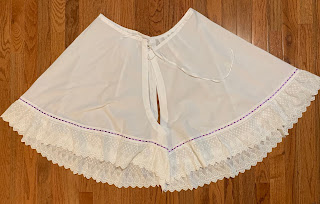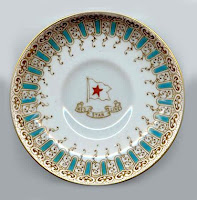Epilogue
I have had requests to provide more detailed photos of the undergarments. And I have to admit they are really pretty! All extant examples of period undergarments are covered with lovely lace and pintuck details, even those bought by middle class women. It's too bad we can't all still expect this level of lovely. I used four patterns to make these garments, as recounted in an earlier blog. Here is what an Edwardian woman wore underneath her dress every day.
The first layer is the chemise. As this layer was worn next to the skin it absorbed sweat and needed to be easily washed, it is a simple garment. I put lace around the armholes, lace beading with white satin ribbon and lace sewn to it and the neck, and then went back over the seam using a wing needle and a pin stitch to add more detail. I sewed all of these pieces except the corset using French seams for a nice, smooth inside. In this era, each piece of all the undergarments in a household were monogrammed so that they could all be easily sorted in the laundry. My monogram is on the large size, but hey, some of this has to be 'just because,' right?

 The corset is worn on top of the chemise. There are lots of period examples of quite vividly colored and highly embroidered corsets. For my first effort, I chose to stick with plain white and I used vintage lace that I found on Etsy around the top. My corset has double coiled steel bones at each seam and a metal busk at the front. Garters are attached at the bottom to hold up cotton or silk hose.
The corset is worn on top of the chemise. There are lots of period examples of quite vividly colored and highly embroidered corsets. For my first effort, I chose to stick with plain white and I used vintage lace that I found on Etsy around the top. My corset has double coiled steel bones at each seam and a metal busk at the front. Garters are attached at the bottom to hold up cotton or silk hose.


On top of the corset comes, of course, the corset cover. This is intended to smooth out the hard lines of the corset. To reduce the layers at my waist and hips, I left off the peplum below the waistline. I used insertion lace, pintucks, lace beading around the neck with white satin ribbon and lace around the neck and armholes, and also used a wing needle to make the pin stitch detail around the neck and armholes, as I had done on the chemise.
The next item to be donned are the split drawers. Some were designed to be worn under the corset; these are meant to be worn over the corset. These are decorated with cotton broderie anglaise trim, and the seam is covered with cotton eyelet beading threaded with purple satin ribbon. I don't know what the point of this piece of clothing is given that there is no crotch seam. I understand why this is the case: with such a long corset and so many layers, there is no way to pull anything down. So they sort of straddled and hovered. But why bother with these? Why not continue to go without? Perhaps it was thought necessary to have this layer because fewer petticoats were worn in this period than had been during the Victorian era? I don't know. These come to just below my knees.

 The final layer of undergarment is the petticoat. In 1912 skirts were becoming much narrower, some to the point of ridicule. This is the era when hobble skirts experienced their brief popularity, and one piece princess slips made their appearance at this time to accommodate the narrower skirts. I did not choose a dress with a narrow skirt and so I used a fuller petticoat pattern. Petticoats and slips had dust ruffles and a flounce over that to keep the skirts looking perfect. I used cotton broderie anglaise for both the dust ruffle and flounce, with cotton eyelet beading on top of the seams threaded with purple satin ribbon.
The final layer of undergarment is the petticoat. In 1912 skirts were becoming much narrower, some to the point of ridicule. This is the era when hobble skirts experienced their brief popularity, and one piece princess slips made their appearance at this time to accommodate the narrower skirts. I did not choose a dress with a narrow skirt and so I used a fuller petticoat pattern. Petticoats and slips had dust ruffles and a flounce over that to keep the skirts looking perfect. I used cotton broderie anglaise for both the dust ruffle and flounce, with cotton eyelet beading on top of the seams threaded with purple satin ribbon.
Et voilà -
The first layer is the chemise. As this layer was worn next to the skin it absorbed sweat and needed to be easily washed, it is a simple garment. I put lace around the armholes, lace beading with white satin ribbon and lace sewn to it and the neck, and then went back over the seam using a wing needle and a pin stitch to add more detail. I sewed all of these pieces except the corset using French seams for a nice, smooth inside. In this era, each piece of all the undergarments in a household were monogrammed so that they could all be easily sorted in the laundry. My monogram is on the large size, but hey, some of this has to be 'just because,' right?

 The corset is worn on top of the chemise. There are lots of period examples of quite vividly colored and highly embroidered corsets. For my first effort, I chose to stick with plain white and I used vintage lace that I found on Etsy around the top. My corset has double coiled steel bones at each seam and a metal busk at the front. Garters are attached at the bottom to hold up cotton or silk hose.
The corset is worn on top of the chemise. There are lots of period examples of quite vividly colored and highly embroidered corsets. For my first effort, I chose to stick with plain white and I used vintage lace that I found on Etsy around the top. My corset has double coiled steel bones at each seam and a metal busk at the front. Garters are attached at the bottom to hold up cotton or silk hose.

On top of the corset comes, of course, the corset cover. This is intended to smooth out the hard lines of the corset. To reduce the layers at my waist and hips, I left off the peplum below the waistline. I used insertion lace, pintucks, lace beading around the neck with white satin ribbon and lace around the neck and armholes, and also used a wing needle to make the pin stitch detail around the neck and armholes, as I had done on the chemise.
The next item to be donned are the split drawers. Some were designed to be worn under the corset; these are meant to be worn over the corset. These are decorated with cotton broderie anglaise trim, and the seam is covered with cotton eyelet beading threaded with purple satin ribbon. I don't know what the point of this piece of clothing is given that there is no crotch seam. I understand why this is the case: with such a long corset and so many layers, there is no way to pull anything down. So they sort of straddled and hovered. But why bother with these? Why not continue to go without? Perhaps it was thought necessary to have this layer because fewer petticoats were worn in this period than had been during the Victorian era? I don't know. These come to just below my knees.

 The final layer of undergarment is the petticoat. In 1912 skirts were becoming much narrower, some to the point of ridicule. This is the era when hobble skirts experienced their brief popularity, and one piece princess slips made their appearance at this time to accommodate the narrower skirts. I did not choose a dress with a narrow skirt and so I used a fuller petticoat pattern. Petticoats and slips had dust ruffles and a flounce over that to keep the skirts looking perfect. I used cotton broderie anglaise for both the dust ruffle and flounce, with cotton eyelet beading on top of the seams threaded with purple satin ribbon.
The final layer of undergarment is the petticoat. In 1912 skirts were becoming much narrower, some to the point of ridicule. This is the era when hobble skirts experienced their brief popularity, and one piece princess slips made their appearance at this time to accommodate the narrower skirts. I did not choose a dress with a narrow skirt and so I used a fuller petticoat pattern. Petticoats and slips had dust ruffles and a flounce over that to keep the skirts looking perfect. I used cotton broderie anglaise for both the dust ruffle and flounce, with cotton eyelet beading on top of the seams threaded with purple satin ribbon.Et voilà -








Comments
Post a Comment